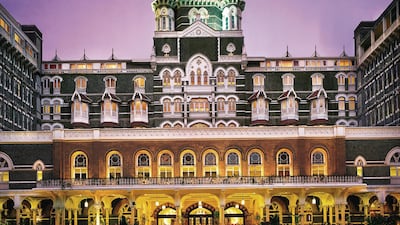The welcome
The main entrance to the hotel is through the lobby of the Taj Mahal Tower, a modern wing that opened in 1973. This used to be a part of the hotel, but the two are now thankfully separate, as the original part of the property, which opened in 1903, is the real draw. This is an extraordinary Gothic-style structure rising to six storeys, with an enormous central dome, on the Colaba waterfront. Security has been increased since the terrorist attacks 10 years ago, and all incoming visitors and guests and their belongings must pass through security scanners. The Palace Lobby, once the original entrance, is where you check-in, and you're at once suffused with a sense of grand history and sharp-but-caring service.
The neighbourhood
Colaba is one of south Mumbai’s most prestigious areas, and the hotel is just across the road from the Gateway of India, and a five-minute walk from the Museum of Modern Art and the southern end of the Oval Maidan. Behind the building are a number of art galleries, and the Colaba Causeway is filled with shops, hotels and restaurants.
The scene
The Taj Mahal Palace is as popular as a hangout for wealthy locals as it is for adoring guests from all over the world, many of whom return time and again for the sense of luxury, reassurance and history it offers in a chaotic city. The pool area and verandah are an oasis of calm, with abundant greenery and birdsong accompanying the slowly whirring ceiling fans and delicate rattan furnishings. Extraordinarily detailed plaster and tile work offsets its sense of solidity and grandeur. The hotel was built by Jamsetji Nusserwanji Tata, founder of the Tata group, after he was apparently turned away from a nearby hotel which under colonial times, allowed “no dogs or Indians”. Between them, the Taj Mahal Palace and the Taj Mahal Tower have more than 500 rooms, and the ground-floor corridor between the two wings, where most of the restaurants are, is busy most of the time. The restaurants are all smart and slick enough to be night-time venues by themselves.
The room
My room is a third-floor standard room; all are slightly different, but I adore mine, with its own hallway, easy-to-use lighting functions, desk space, separate sitting area and marble bathroom. There’s also a walk-in wardrobe. The hotel has achieved a balance between modern comforts and freshness, and maintaining enough original features to hint at bygone ages. There’s a deep, fast-filling bath, high ceilings and wood floors, decorated in neutral tones. The thickness of the walls and solid doors give you a sense of protection and quiet rarely felt in hotels these days.
The service
One of the selling points of Taj's flagship property and not a let-down. Here, staff seem to delight in their work and you feel like an individual, without it being obtrusive. Each floor has its own butler who delivers whatever is promised, such as a sweet mint drink on arrival in the room or harder pillows. Calls to "palace services" are answered promptly. At the end of a long day's walking, a staff member brings me a foot spa and runs a hot milk bath for me. There's a bit of a long wait to get a table at breakfast at Sea Lounge, but this is because people take their time looking at the views.
The food
Combined with the Tower wing, there are 11 food and beverage outlets. There's a choice of breakfast buffet locations: I loved Sea Lounge on the first floor: great pastries, coffee and Indian dishes. Wasabi by Morimoto is a high-end Japanese restaurant; it's expensive but worth it, especially if you arrive late and only want a light meal. The Indian speciality restaurant is Masala Kraft on the ground floor, which provides enough reason not to go outside. The Galoti kebab, made with finely minced lamb and 16 different spices (1,500 Indian rupees; Dh77) is excellent and the tiffin stacks (from 3,050 rupees) are good. The Chinese restaurant, Golden Dragon, also has a high quality and decent value set menu from 2,500 rupees per person.
Loved
My room and favourite breakfast spot, in the original section of the Sea Lounge, which has no air-conditioning and offers fans, wicker chairs and direct views of the sea. The decadent verandah and pool areas, although food here is limited and expensive.
Hated
While the room rates can be reasonable, the food prices are excessive, especially when compared to local restaurants. A tandoori paneer pita, for example, costs 1,600 rupees (Dh82). You're paying at least as much for the place and assured cleanliness as for the actual food.
The verdict
An exceptional hotel and welcome base in a frenetic city.
The bottom line
Double rooms at The Taj Mahal Palace (www.tajhotels.com) cost from 24,500 rupees (Dh1,269) per night, including taxes and breakfast.

